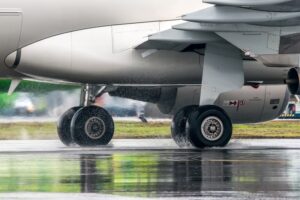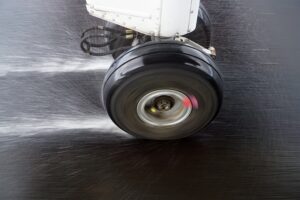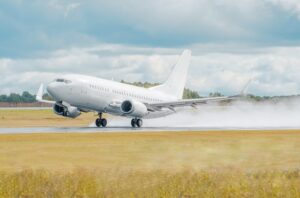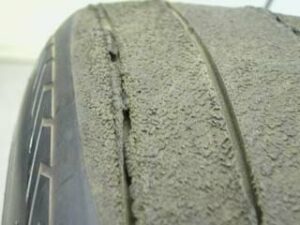Hazards Associated with Hydroplaning
Wet weather season is upon us, and it is wise to review how to safely navigate inclement weather conditions. Wet weather can make air travel precarious both in the air and on the ground—during takeoffs and landings. In this article, we will address the types of hydroplanes, their causes, and how to avoid them.
The three basic types of hydroplaning are:
- Dynamic hydroplaning
- Viscous hydroplaning
- Reverted rubber hydroplaning.
Each of these are equally dangerous and have the potential to cause an aircraft to veer off a runway.
Dynamic hydroplaning develops at high-speeds during takeoffs or landings, but can persist to significantly slower speeds once it occurs. For this to transpire, a thin film of water of at least one-tenth inch deep must be present on the runway. While a moving tire is in contact with the runway, the water ahead of the tire begins to accumulate. As the aircraft moves, and especially as speed of the aircraft increases, so does the accumulation of water ahead of the tire, resulting in a wedge of water between the tire and the runway. Once the water pressure reaches a point it is able to support the weight of the airplane, the tire is lifted off the runway and no longer has frictional contact with the runway. Braking and directional control is lost and the tire stops rotating due to the lack of frictional contact with the runway.
Dynamic hydroplaning occurs when the groundspeed is at least 8.73 times the square root of the tire pressure of the main tires. For example, the minimum speed for dynamic hydroplaning with a tire having an air pressure of 121 PSI is 96 kt.
Viscous hydroplaning occurs due to the viscous properties of water. Take, for instance, your kitchen floor covered in a layer of cooking oil. If you were to walk into your kitchen, you would likely slip and fall. This is because the soles of your feet are not able to penetrate the oil due to it’s thickness and viscosity, preventing any frictional contact with the floor. In the same vein, this can occur with aircraft on runways with at least one-thousandth of an inch of water. The tire is unable to penetrate through the layer of water and remains lifted over the runway. Viscous hydroplaning is particularly insidious over smooth areas of the runway (such as landing points where rubber accumulates from repeated landings) as the aircraft may hydroplane at much slower speeds than if it were dynamic hydroplaning. To put it into perspective, such smooth surfaces can have the same friction coefficient as wet ice.
Reverted rubber hydroplaning requires only a thin film of water on the runway. It occurs when the pilot brakes heavily on wet runways, causing the wheels to lock and the tires to skid. The heat generated by friction causes one or more tires to revert to their uncured state (i.e., melt). This traps water between the tire and runway, which isconverted to steam due to the heat and lifts the tire off the runway. Reverted rubber hydroplaning is particularly dangerous becausepilots may not be aware it is occurring and it may persist at very low speeds (20 knots or less).
How to Avoid Hydroplaning
 It is first important to be aware of wet conditions and runway characteristics at your destination. Has it rained at your destination? Should you be expecting to land on a wet runway? Is your expected runway grooved? Be aware that grooved runways do not eliminate hydroplaning, but rather can serve to reduce it to a manageable level. The grooved texture provides better drainage and traction, but wet grooved runways should still be approached with caution. Plan also for a “firm” touchdown, to put the tires solidly against the pavement. An astute pilot should also ensure before the flight that there is sufficient runway available in wet conditions based on the Pilot Operating Handbook.
It is first important to be aware of wet conditions and runway characteristics at your destination. Has it rained at your destination? Should you be expecting to land on a wet runway? Is your expected runway grooved? Be aware that grooved runways do not eliminate hydroplaning, but rather can serve to reduce it to a manageable level. The grooved texture provides better drainage and traction, but wet grooved runways should still be approached with caution. Plan also for a “firm” touchdown, to put the tires solidly against the pavement. An astute pilot should also ensure before the flight that there is sufficient runway available in wet conditions based on the Pilot Operating Handbook.
Secondly, in wet conditions, your touchdown speed should be as low as is safely possible. This lowers the chances of dynamic hydroplaning occurring. After the nosewheel is lowered to the runway, moderate braking should be applied. Again, proper braking technique is essential, as heavy braking and locking up the tires will only make you more susceptible to hydroplaning. The brakes should be applied firmly until reaching a point just short of a skid. At the first sign of a skid, the pilot should release brake pressure and allow the wheels to spin up before moderately applying brakes again.
If you suspect hydroplaning is occurring, you may raise the elevator and utilize aerodynamic drag to decelerate to a point where the brakes become effective. Pulling back on the yoke or stick improves your chances of penetrating the layer of water by increasing drag on the aircraft, which slows it and accumulates weight on the main gears.
Directional control should be maintained at all times with the rudder. Maintaining directional control with a lack of runway traction becomes significantly more sensitive, so be sure to avoid over-correcting. In a crosswind, if hydroplaning occurs, expect the aircraft to weathervane into the wind while simultaneously sliding downwind. If possible, divert to a more suitable airport as a form of risk management.
Test your knowledge of hydroplaning with these question found in the Gleim Aviation Test Prep for the instrument rating and Airline Transport Pilot certificate.
1. What is the best method of speed reduction if hydroplaning is experienced on landing?
A) Step hard on the brakes.
B) Hold nose up.
C) Go around.
2. What effect, if any, will landing at a higher-than-recommended touchdown speed have on hydroplaning?
A) No effect on hydroplaning, but increases landing roll.
B) Reduces hydroplaning potential if heavy braking is applied.
C) Increases hydroplaning potential regardless of braking.
3. Under what conditions might a pilot expect the possibility of hydroplaning?
A) When landing on a wet runway that is covered in rubber from previous landings.
B) When departing a grooved runway with less than a thousandth of an inch of water.
C) When the adiabatic lapse rate is high, and steam is rising from the landing surface.
See below for answers.
Written by: Ryan Jeff (CFI, AGI), Aviation Research Assistant
Answers
1. B
2. C
3. A





